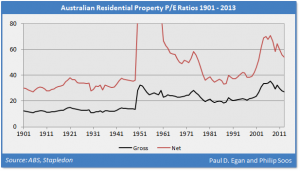Between 1996, when real housing prices began to boom, and 2006, just before the onset of the GFC, Australia built, on average, one new dwelling for every 1.5 new net persons. The ratio then surged during the GFC as uncertainty, debt deleveraging, fraud and insolvencies swamped property developers, leading to a reduction in the rate of building completions. The rising ratio was boosted by the government's foolishly high population growth policies via immigration as they sought to lift the weakening economy.
Advertisement
This appeared to create a genuine housing shortage between 2007 and 2010, as both the nominal rent to inflation and rent to income ratios strongly increased, and the ratio of new people per new dwelling exceeded the overall occupancy rate (2.7) for the first time in over four decades.
After 2010, nominal rents tracked the rate of inflation, and are now falling steeply in Perth and Canberra, with Brisbane likely to follow on the end of the mining investment boom. This indicates the GFC-induced shortage has abated, and supply has resumed its trend, even in the face of higher population growth.
It should be noted that most demand for housing comes from buyers, not tenants. Thus, a rise in imputed rents on owner-occupied housing, not actual rents on the investment property stock, signals a shortage in the housing market. Unfortunately, data series of quality-adjusted imputed rents are not available, and would still technically require the 'user cost of capital' method to properly assess the trend in imputed rents.
Nevertheless, the long-term residential price to rent ratio, which combines total imputed and actual rents, experienced a steep surge beginning in 1996. Economist Dean Baker, who identified the US bubble back in 2002 and predicted the GFC, noted "No one can produce an explanation as to how fundamental factors can lead to a run-up in home sale prices, but not rents."

Advertisement
From the trends identified in the graphs, it is clear the supply of housing has been more than sufficient to meet new net population growth. In some years, there has been more than one dwelling built per person, while at other times, there has been a continual growth of housing supply while population growth turned negative. Over the course of the housing price boom beginning in 1996, Australia has built, on average, one new dwelling for every 2.0 new net persons. This is in line with the post-WW2 average of 2.0 between 1946 and 2012.
The inadequacy of the housing shortage argument is apparent for the trend in the NSW ratio. Sydney, which dominates the state's housing market, experienced a massive price boom between 1996 and 2004, yet over this period, one new dwelling was built for every 1.4 new people. At the peak in 2004, the ratio decreased to an insane 0.2 (the trend line removes some of the visible precision in the ratio). In other states and territories, the ratio turned negative, indicating negative population growth in the face of positive dwelling construction, even while prices remained steady or even rising.
The housing booms in both the US and Ireland was blamed on shortages, but the real cause of high prices were speculative bubbles. The graph below shows that between the mid-1990s (when prices began to rise) and the GFC, Australia's supply was superior to that of the US, but below that of Ireland. The latter country had an epic building boom, with a ratio of 1.1 between 1995 and 2007, the trough and peak of real housing prices.
Discuss in our Forums
See what other readers are saying about this article!
Click here to read & post comments.
1 post so far.